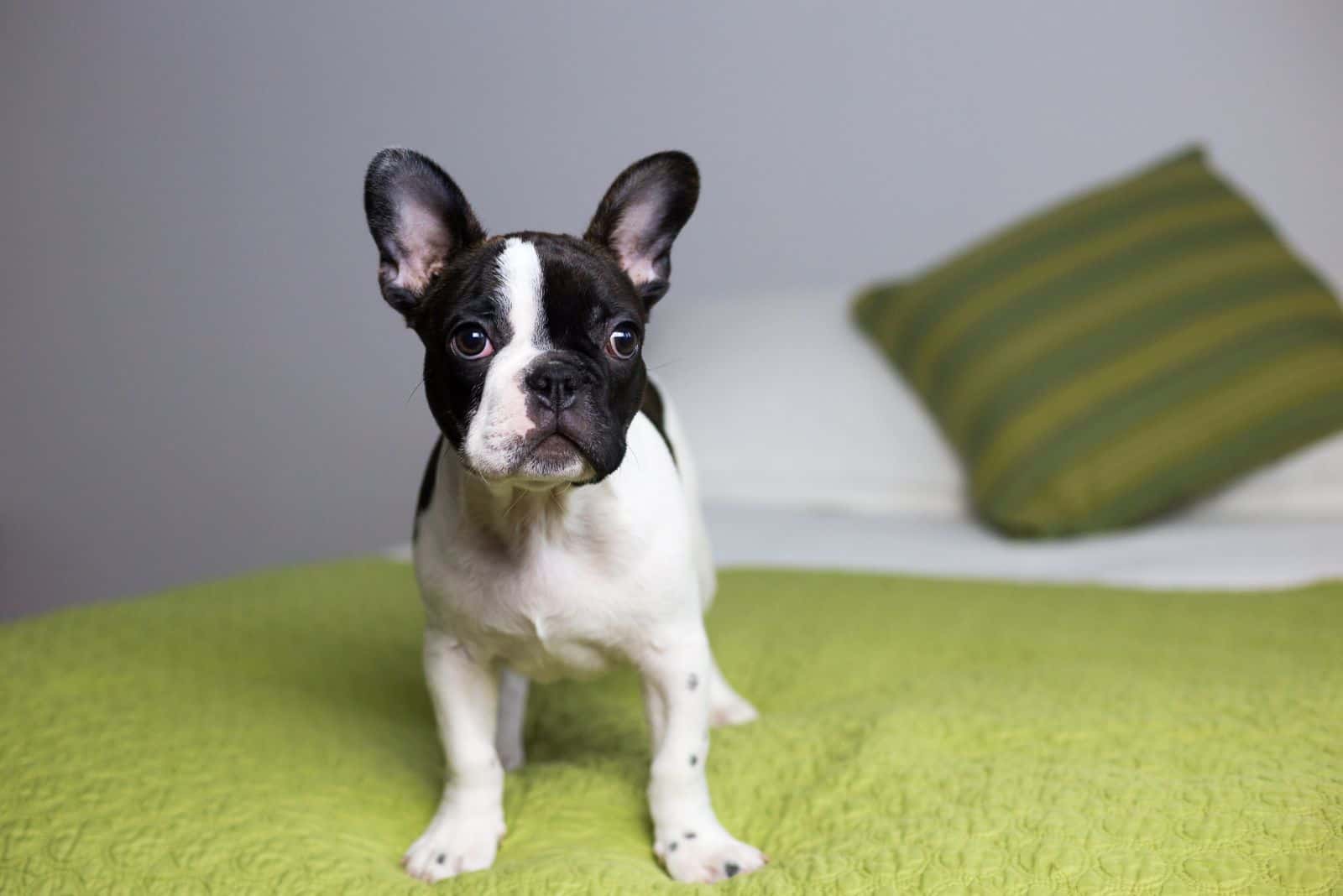The fact that French Bulldogs are among the most popular dog breeds worldwide is not surprising. Many Frenchie owners adore this small dog’s friendly demeanor and keen sense of fun.
The Pied French Bulldog is one of many coat colors and patterns available for Frenchies.
Everything you need to know about these lovable dogs will be covered in this in-depth breed guide, including their physical characteristics, temperament, size, health problems, requirements for exercise, and grooming.
We will also be listing some different Pied French Bulldog colors!
But let’s first define what “pied” means.
People refer to a particular pattern observed in some dogs, such as Frenchies, as “piebald” when describing them.
The right term for a breed like the French Bulldog is “pied,” despite the fact that most people mistakenly use the words interchangeably.
The coat of a Pied French Bulldog puppy is primarily white, with obvious patches of a darker color covering particular areas of the head, body, or occasionally both.
What Is The Pied French Bulldog?
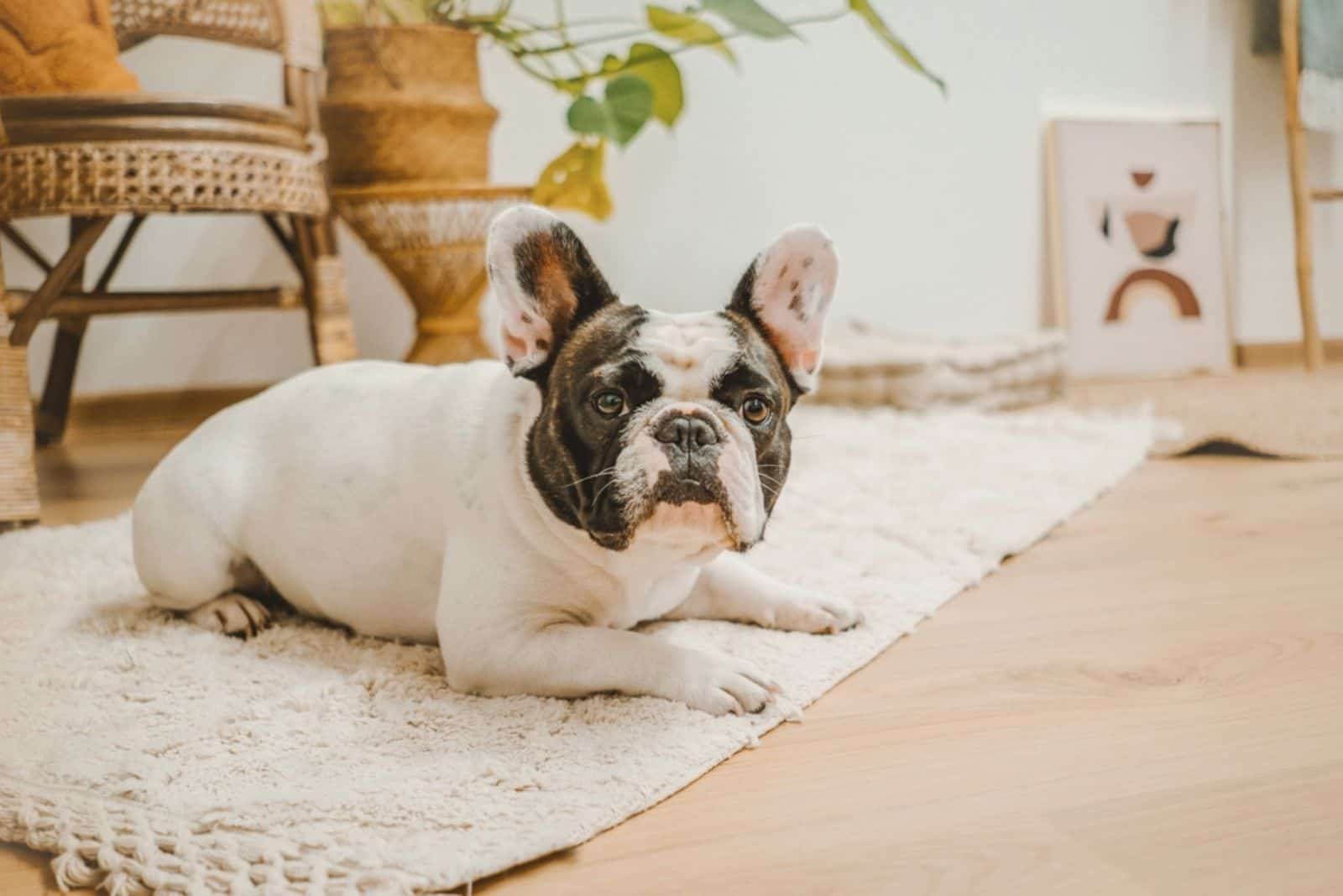
We know that French Bulldogs come in a lot of different colors.
A French Bulldog with a Piebald coat pattern is known as a Pied French Bulldog. The Piebald French Bulldog is identical to other French Bulldogs save for its distinctive coat.
But what does Pied in French Bulldog mean?
Pied, sometimes known as Piebald, is a pattern with a base coat of white with sporadic patches of a different color. Pied is a pattern rather than a color, thus when someone refers to a French Bulldog as being a “Pied color,” they are actually referring to the pattern.
A recessive gene is responsible for the Piebald Frenchie‘s look, hence breeding two Pied French Bulldogs will result in Pied puppies. Pied offspring are half as likely to be born if one parent is a solid hue.
About The French Bulldog Breed
The French Bulldog has a long history of being a beloved companion animal.
The French Bulldog was developed in England as a miniature version of the English Bulldog. The breed was highly popular among lace workers in the city of Nottingham, so when many of them left for France in search of better possibilities, they naturally took their small Bulldogs with them.
The French Bulldog flourished in France and throughout Europe, and Americans quickly learned how charming it was as well.
At the Westminster Kennel Club exhibition in 1896, the first French Bulldog was ever seen in the United States. The breed was given the endearing moniker “Frenchie” quite early, and it is still used today.
From there, the breed just kept getting more and more varied, and today there are a lot of various Frenchie colors and patterns, including special cases such as brindle and sable.
How Does The Pied Pattern Come About In French Bulldogs?
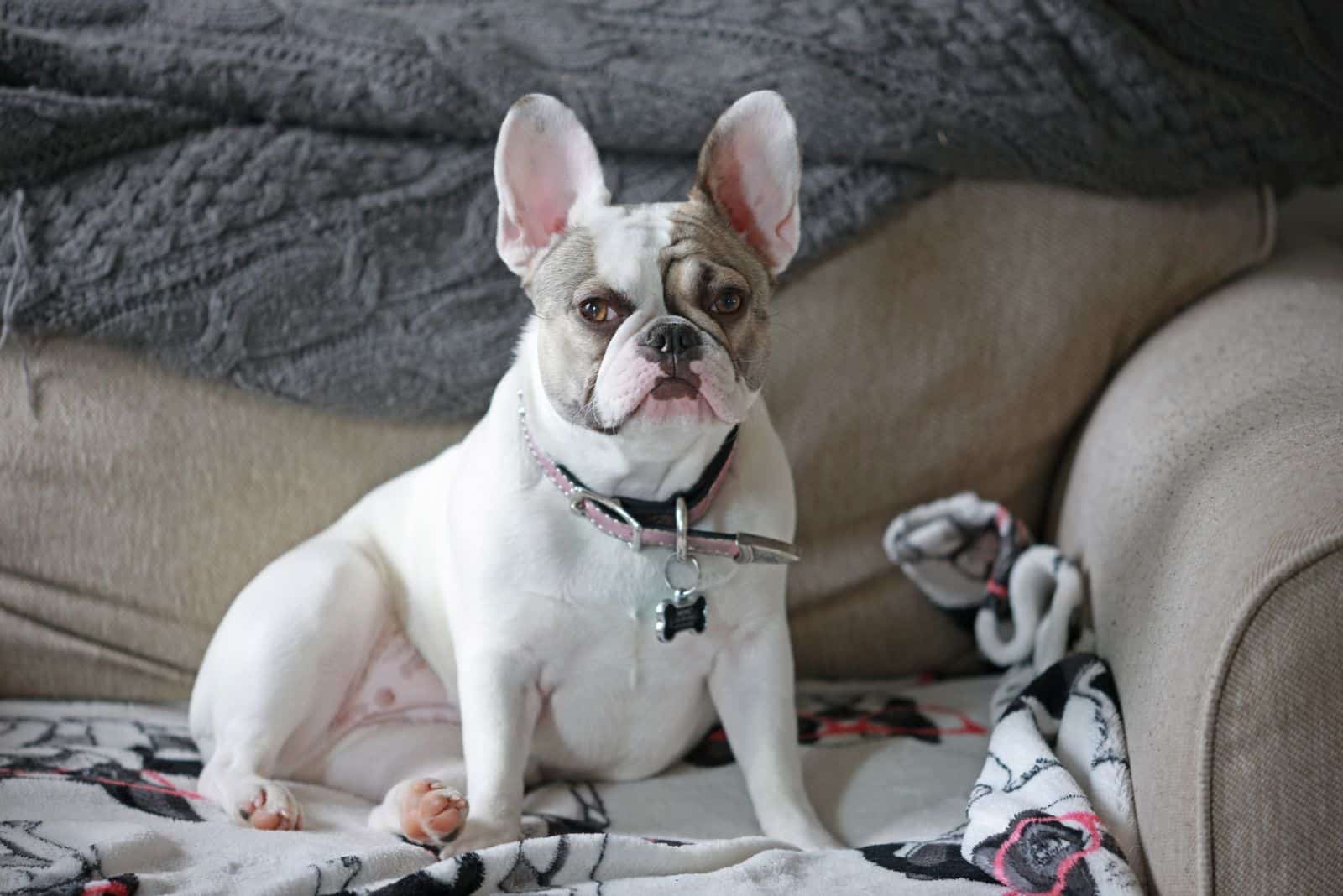
The chromosomes in your dog’s body are home to its genes.
Every dog has 39 pairs of chromosomes in total. One of these 39 pairs—the pair that determines whether a dog is male or female—is a sex chromosome pair.
A gene’s autosomal inheritance just indicates that it is present on one of the other 38 pairs of chromosomes. This indicates that there is an equal chance that a male and female dog will carry the gene.
Recessive means that for the trait to manifest, a dog needs to inherit both copies of the gene. In this case, the gene in question is the one that carries the pied coat pattern.
Without completing a genetic test, it won’t be simple to determine whether the dog is a carrier.
You cannot produce a Pied French Bulldog by mating a Pied Frenchie with a Frenchie of a solid color who is not a carrier of the pied gene. Instead, you will have Frenchies that are entirely solid-colored and Pied gene carriers.
Is Pied A Recognized Coat Pattern?
Piebald is a pattern for French Bulldogs that is recognized by all significant kennel clubs.
However, not every Pied French Bulldog hue is regarded favorably by everyone. For instance, the American Kennel Club (AKC) only accepts Pied French Bulldogs in the colors cream, fawn, and brindle.
Are Pied French Bulldogs Rare?
Frenchie enthusiasts who enjoy seeing unusual color combinations in their favored breed are mostly responsible for the Pied Frenchie’s appeal.
The demand for the breed has also been influenced by its alleged rarity and breeders’ marketing.
Piebald Frenchies come in a variety of hues and blends. Fawn and brindle Pied Frenchies are very common, but blue, lilac, sable, and merle Pied horses are more difficult to locate.
Pied French Bulldog Color Patterns
As we already noted, the word Pied generally refers to a coat pattern in French Bulldogs. It can come in a wide range of different color combinations, each one more beautiful than the last.
The French Bulldog has a wide range of Piebald markings. You should be aware nevertheless that not all of them adhere to AKC standards.
We’ll look at a few Pied French Bulldog variations now, some of them are considered relatively standard colors, while others are truly rare colors.
Blue Pied French Bulldog
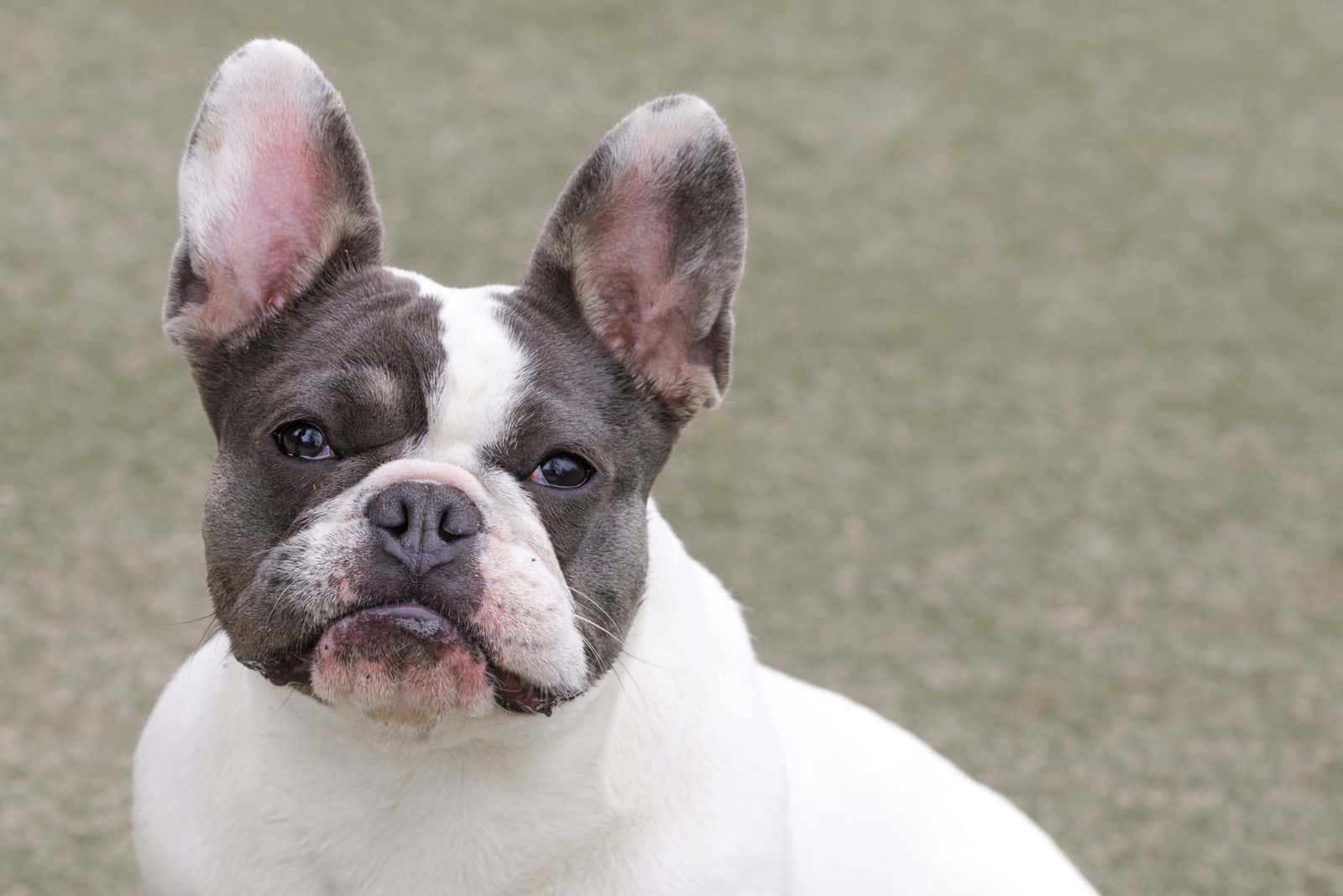
The unique bluish-gray patches adorn the white coat of the Blue Pied Frenchie. A dilution gene that lightens the black pigment in a Frenchie’s coat causes the blue coloring.
The Blue Pied Merle French Bulldog is another name for this breed. You cannot register your Blue Pied Frenchie with the AKC since this color is not officially recognized by them.
Fawn Pied French Bulldog
Next up on the list of the most adorable Pied Frenchie patterns is the gorgeous Fawn Pied.
The base coat of Fawn Pied Frenchies is white with light yellowish-tan patches. They are acceptable for showing and registration purposes, according to the AKC.
A French Bulldog with blue paw pads, eye rims, nose, and lips is known as a Blue Fawn Pied. This puppy is exactly like a regular Fawn Pied Frenchie, with the exception that the areas that should be black are instead blue.
Lilac Pied French Bulldog
Similar to how blue is diluted black, lilac is diluted chocolate.
Lilac spots cover the white coat of a lilac Pied Frenchie. You can also refer to these puppies as Lilac Pied Merle French Bulldogs because they frequently have the merle gene.
Lilac Fawn Pied French Bulldog has a white coat with lilac and fawn spots.
Even though the hues can be difficult to detect, observant pet owners won’t have any trouble spotting the slight shade differences.
Brindle Pied French Bulldog
The base coat of this particular French Bulldog is white with brindle spots. The Pied Brindle Frenchie will have fawn or brown patches with black vertical lines, resembling the stripes on a tiger.
Other Pied Frenchie color variations include Chocolate, Sable, and Cream Pied Frenchies, as well as White French Bulldogs and many others.
Pied French Bulldog Size
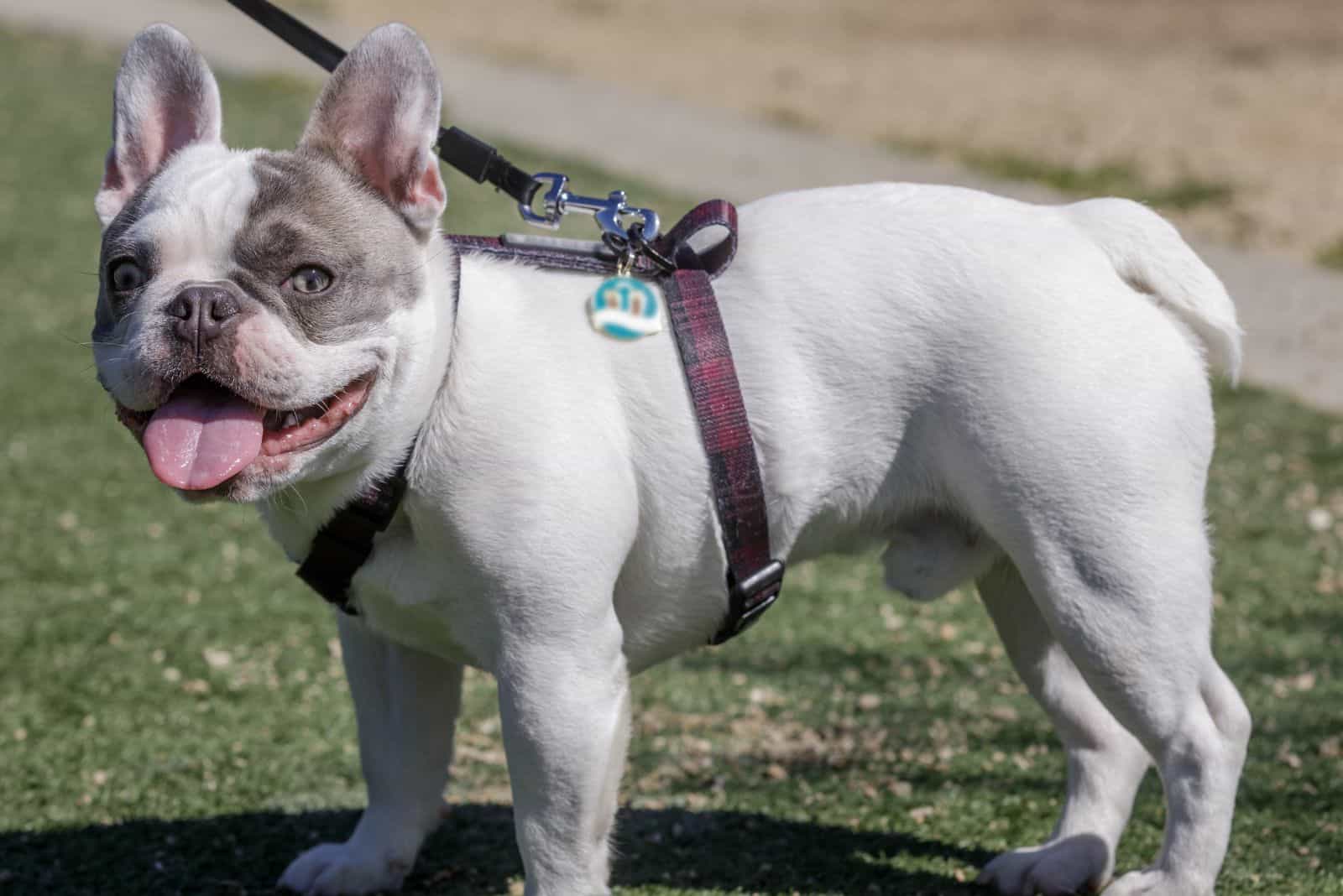
The general body proportions of Frenchies are unaffected by their gender or color. For instance, the dimensions of a female Blue Pied French Bulldog and a male Pied French Bulldog are comparable.
Frenchies can weigh up to 28 pounds and grow to a height of 11 to 13 inches.
They may easily be kept in small apartments because they are so little.
This is practical in a culture that is increasingly drawn to urban living. A French Bulldog can live in any home, even one without a backyard.
Pied French Bulldog Personality And Temperament
The demeanor of the Pied French Bulldog is similar to that of other Frenchies, making it a wonderful family pet. They are also quite amiable with both people and other animals.
Although they may survive in small apartments, these puppies still need some daily fun and mild exercise. Your Frenchie shouldn’t be kept indoors all day long as this could lead to behavioral problems.
Are Pied Frenchies Good Family Dogs?
Due to their petite stature, mild temperament, and playful demeanor, Pied Frenchies are wonderful family pets. They are less delicate than other toy breeds and are able to maneuver around clumsy children.
Pied Frenchies cannot seriously harm your children because they are so little and light, but also simply because they are not that aggressive.
Pied French Bulldog Diet
Pied Frenchies enjoy a high-quality, largely meat-based diet. They thrive on dry kibble that is strong in protein and low in carbohydrates.
A French Bulldog should typically be fed a diet that contains at least 18% protein and 5% fat, as well as additional vitamins, minerals, and carbs.
Lean meat, omega-3 fatty acids, natural ingredients, and moderate-calorie foods are among the suggested things to feed your French bulldog.
Pied French Bulldog Physical Activity
Pied French Bulldogs need a moderate amount of exercise every day since, despite their energy, they are prone to overheating and weariness. They can get all the exercise they require by taking a short stroll around the neighborhood or in a park.
Given that they are regarded as low-energy breeds, Pied French Bulldogs don’t require a lot of exercise. They have short muzzles and narrow noses because of their brachycephalic faces, which in some way restrict the flow of oxygen to their bodies.
However, they have large chests and require quick workouts to maintain a healthy weight.
These adorable, short-legged dogs benefit from daily brief walks, chasing objects, catching balls, and other workouts. A motion-activated toy can also properly satisfy their urge for exercise.
Due to their short muzzles, which force them to lean their bodies backward in order to maintain their mouth and nose above water, Frenchies are unable to swim.
When your Frenchie is near rivers, ponds, or swimming pools, you should always take extra precautions to protect him.
Pied French Bulldog Training
Pied Frenchies can be simple to train but they can grow tired rapidly, so you’ll need to train them using fresh, entertaining methods and limit the length of each training session.
Like other dogs, French Bulldogs benefit from positive training techniques that emphasize fun and food rewards to reinforce learning objectives. The complete range of polite puppy behaviors can be mastered by Frenchies, which are people-oriented canines that enjoy picking up new skills.
Even untrained adult Frenchies can pick up manners, though it is better to start training them when they are still puppies, especially when it comes to potty training.
Puppies of the French Bulldog breed can begin learning fundamental obedience commands as early as eight weeks of age. But it’s never too late to start training your French Bulldog.
Even the most resistant students can be won over by positive training techniques and a pocket full of treats, despite the fact that adult Frenchies may be more set in their ways.
Pied French Bulldog Grooming
Your Pied Frenchie will require similar grooming as any other breed. Once or twice a week, you should brush their coat, and if needed, give them a wash.
When giving your dog a wash, be sure to use dog-friendly shampoo to keep their coat and skin hydrated and healthy.
Regular cleaning is also necessary for your Frenchie‘s large ears. It’s simple to overlook the wrinkles on these dogs. In between baths, make sure to wipe them down with a damp cloth or dog wipes to prevent the growth of bacteria.
Pied Frenchies require only periodic brushing to remove stray hair and distribute natural oils evenly, maintaining the condition of their coats.
They are medium shedders and have short hair, so they don’t have a significant shedding issue. Therefore, scheduling the hair combing tasks for the weekends is always an option since brushing their coats once a week would do.
To avoid the possibility of bacterial infection, make an effort to keep the flaps and wrinkles on their body dry and clean. Dry the skin in between the folds carefully after each cleaning.
Are Pied Frenchies Hypoallergenic?
In short, the Pied French Bulldog is not a hypoallergenic breed of dog. If you want the longer answer, we have a whole article that delves into that topic.
These puppies are not recommended for those who have dog allergies because they significantly shed throughout the year.
If you are one of those people who are prone to allergies, you might be better off choosing a different, more hypoallergenic dog breed.
Pied French Bulldog Health
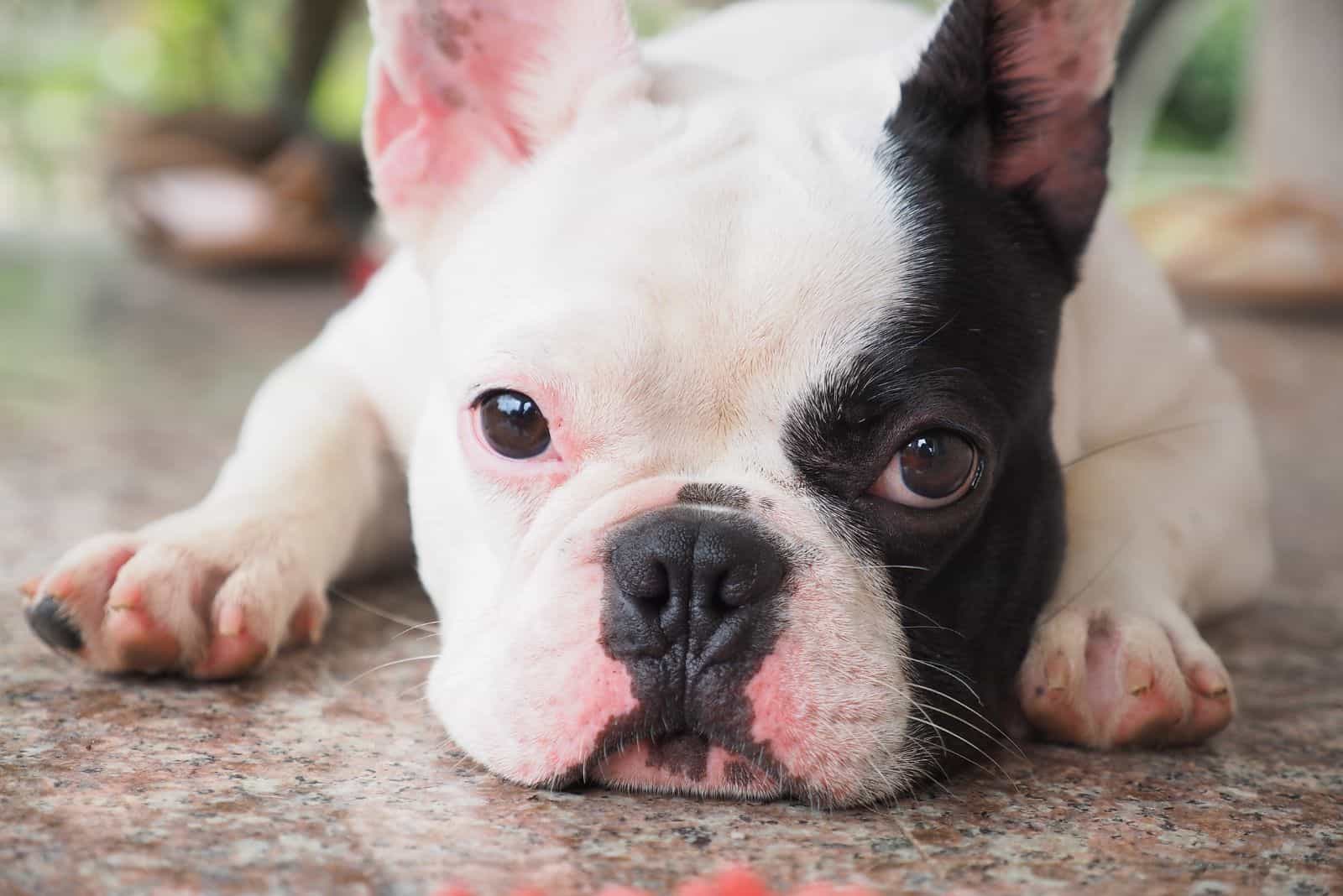
All types of French Bulldogs, including Pied Frenchies, are more susceptible to a number of medical conditions than a lot of other dog breeds.
Their genetic makeup and body shape are big factors in this as they are the cause of most of those concerns. While not all of those conditions are fatal or even serious, they still require a higher level of care and attention from Frenchie owners.
If you’ve ever owned a French Bulldog before, you will definitely know that they need special treatment when it comes to their health.
Common Health Issues In Pied Frenchies
As we’ve already said, Pied French Bulldogs are more prone to a lot of health problems than many other breeds.
Some of them are more severe than others, but it’s good to know as much as you can about all of them if you want to adopt a Frenchie.
With that in mind, here are a few words about some of the most common health issues that affect Pied Frenchies.
Hip Dysplasia
Among small breeds like French Bulldogs, hip dysplasia is uncommon. It is caused by improper hip socket formation, which results in painful arthritis and lameness.
The hip’s bone and cartilage start to deteriorate as the dog grows. This eventually results in arthritis, muscular atrophy, and decreased mobility.
Large-breed dogs are more frequently affected, and research indicates that it is inherited.
Hip dysplasia in dogs can cause long-term arthritis, although early detection of the condition can lessen or even prevent this from happening. Canine hip dysplasia can be treated in a number of ways, including a few surgical procedures and pharmaceutical management.
Elbow Dysplasia
When the elbow joint does not develop properly during embryonic development, it is called elbow dysplasia. In the end, it results in arthritis and causes pain and lameness in the front legs.
Normal symptoms of affected dogs include front leg lameness, which can appear as early as 5 months of age. The limping may come and go, getting better with rest and getting worse with exercise.
Dogs with elbow dysplasia do not always exhibit symptoms.
Patellar Luxation
This condition frequently affects small dogs, such as Frenchies, and happens when the patella is out of alignment and luxates.
Kneecap displacement in your Frenchie results in patellar luxation. Even when it’s not painful, it can still be a hassle.
Depending on the severity of the condition, treatment options for a canine luxating patella range from conservative medicinal care to surgery.
Patellar luxation surgeries can either treat bony issues or soft tissue structures. Regardless of the procedure used, the main objective is to realign the knee’s supporting structures so that the kneecap can move normally and remain in the femur’s groove.
Brachycephalic Syndrome
Their brachycephalic faces have detrimental effects on their health, including restricted noses, blocked airways, trouble with the eye sockets, and dental disorders.
The symptoms of the illness range from airway collapse to noisy or laborious breathing, snoring, and snuffling.
Additionally, a puppy with brachycephaly has a shorter head and face. Breathing becomes challenging when the respiratory system is affected by issues like stenotic nares.
Tracheal Collapse

When your French bulldog inhales, it may experience its windpipe collapsing, if it is suffering from this medical condition.
Tracheal collapse can lead to breathing issues as well as other consequences.
Legg-Calve-Perthes Disease
This condition indicates that the hip joint in your dog has stopped growing at the proper angle. The back legs become painful and the Frenchie starts to limp as a result.
The precise origin of Legg-Calve-Perthes disease is not known. According to studies, impaired blood flow to the hip may be a factor, and this impairment may be brought on by blood vessel clots. Small fractures result from the bone’s deterioration and weakened state.
Medical treatment can frequently be used to address mild instances. Painkillers are frequently administered to keep the dog at ease. Additionally, it’s crucial to prevent overweight in affected dogs as this would put more strain on the joints.
Your veterinarian could also advise surgery if the condition is severe.
Corneal Dystrophy
The eyes are a particularly sensitive area in all dogs that have the brachycephalic head shape. Pied Frenchies are no exception.
The illness known as corneal dystrophy prevents the cells on the surface of your Pied French Bulldog’s eyes from growing and usually causes some sort of eyesight loss.
Cataracts
This illness causes a blue or gray film to form around the eyes. Although your Frenchie could need corrective surgery, cataracts are not painful.
Young and old dogs both develop cataracts. Genetic inheritance, metabolic disorders, diabetes, trauma, nutritional imbalance, and chronic uveitis are some of the causes.
The two primary reasons to think about having cataract surgery for your dog are to restore their vision and to prevent the issues caused by persistent cataracts.
The success rate of canine cataract surgery has been reported to be as high as 80–90% for ideal surgical candidates, and generally speaking, the earlier the surgery is performed, the better the results.
Color-Related Deafness
As evidenced by merle pups, French Bulldogs are one of the canine breeds that can develop color-related deafness.
It would be wise to inquire about the dog’s deafness from the breeder if you intend to get a Pied Frenchie puppy.
Bring your adult dog to the vet, who will do hearing tests, if you notice any problems.
And if your Frenchie has hearing problems, don’t worry. Even hearing dogs can go about their lives without any serious issues. They don’t feel this the same way that people do.
Deaf Frenchies can still make wonderful pets, but future breeding is not advised. Despite any potential health difficulties, these are affable dogs who make wonderful family pets.
How Long Do Pied Frenchies Live?
A healthy Pied French Bulldog can live between 10 and 12 years if kept in good health.
However, since they are susceptible to all of these different problems and diseases, keeping it fit and healthy can often be a challenge. That’s why these dogs aren’t typically recommended to first-time pet owners. They really require a lot of care and attention.
Pied French Bulldog Price
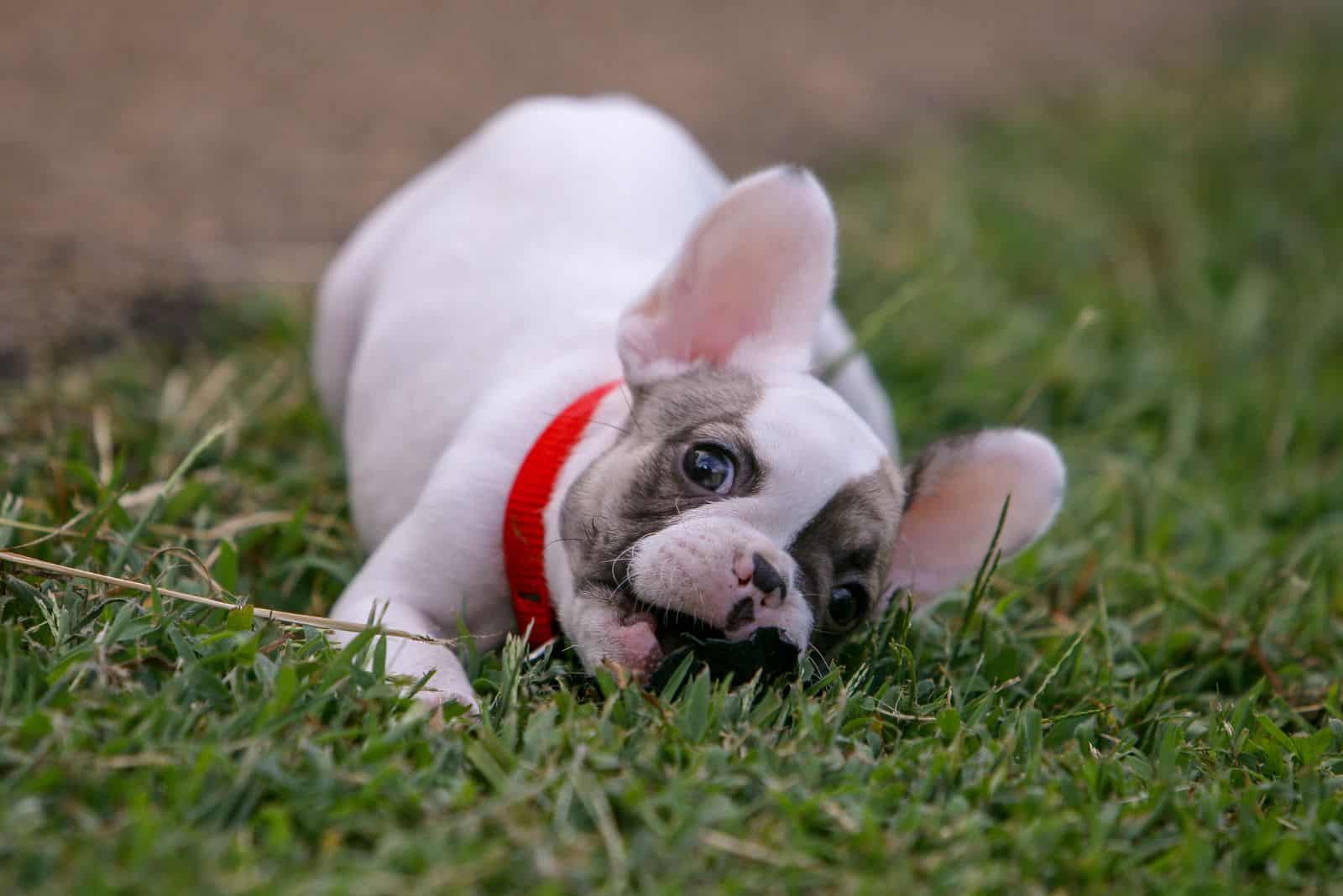
The cost of a Frenchie varies according to the breed, location, and color of the coat, but the average range seems to be between $1,500 and $3,000.
However, Frenchies with great breeding lines tend to be even more expensive, with some going for as much as $10,000, like other sought-after breeds.
Whelping and dystocia difficulties are one of the main causes of some Frenchies’ ability to command such high prices. Due to their narrow hips, a higher percentage of Frenchies cannot birth puppies naturally, and even when they do, they generally have smaller litters.
Therefore, the high prices reflect the expenses associated with Caesarean sections, artificial insemination, and genetic testing.
However, a responsible breeder should never give the excuse that a Frenchie is expensive because of its unique coat pattern. The word “rare” is frequently used in advertising to give the impression that the puppy you are going to purchase is unique compared to other puppies.
Rare coat patterns can be stylish, but they can also refer to unattractive colors that are not typically associated with Frenchies. This implies that such colors may have unfavorable health effects, which many Frenchie enthusiasts and communities are unaware of.
Make sure the breeder of your Pied French bulldog is licensed by a respected Kennel Club and is a reputable breeder. Registered breeders make every effort to keep your puppy healthy and content.
Additionally, try to meet the puppy’s parents to assess their health and personalities.
Where Can I Get A Pied Frenchie?
There probably aren’t many breeders who focus solely on Pied French Bulldogs, but there are a lot of those who breed Frenchies in general.
Frenchies are a hugely popular breed across the world, and especially in the United States of America, so finding a French Bulldog breeder who produces these pups shouldn’t be too hard.
Once you’ve found some reputable ones, you can do some research, or get in touch with them directly, in order to find out if they breed Pied Frenchies.
How To Breed A Pied Frenchie?
What makes a Pied Frenchie? The autosomal recessive gene. In other words, for a pup to have pied markings, a precise gene combination from both parents must be inherited.
We’ll provide examples to help us explain.
You will surely have a litter of pied puppies if you breed two pied dogs. While the specific pattern cannot be predicted, all dogs will have a piebald coat.
If you want to know if your dog carries the pied gene, you can test its DNA.
Things become a little complicated if you happen to know two dogs with solid colors possess the pied gene and you breed them.
In this litter, 50% of the puppies will be solid-colored but carry the hidden pied gene, 25% will be pied, and 25% will be a solid color.
Is The Pied Frenchie The Right Dog For Me?
The Pied French Bulldog is identical to an ordinary Frenchie in every way except for its beautiful coat. The Pied Frenchie is just like the other Frenchies, which are among the best toy pets you can buy.
You will discover the Pied French Bulldog to be a lovable, healthy, friendly, and playful pet companion as long as you can take care of their well-being.
If you are ready for all the potential health risks and are prepared to provide your Frenchie with all the extra care it requires, then you will be rewarded with a pet who loves you unconditionally.
Conclusion
We hope this article has given you a solid understanding of the fundamentals of Pied French Bulldogs and what to anticipate when you decide to bring one home.
All things considered, Pied French Bulldogs are fantastic breeds. They are distinctive, devoted, kind, perceptive, and adorable.
They do, however, have particular difficulties of their own, much like other breeds. But the advantages of owning these tiny dogs outweigh any potential drawbacks with adequate maintenance, training, and preventative methods.
While purchasing a Pied French Bulldog puppy could put somewhat of a dent in your wallet, you’ll quickly come to the conclusion that having this devoted breed is well worth the cost.
